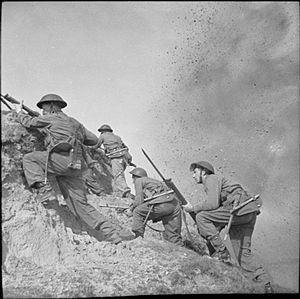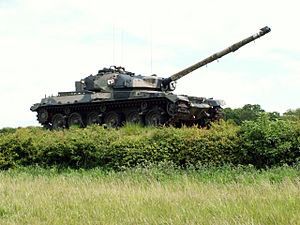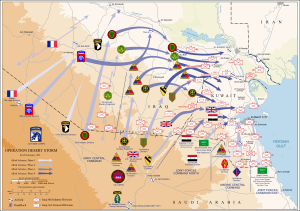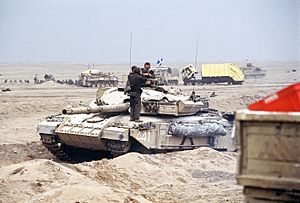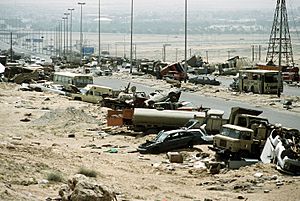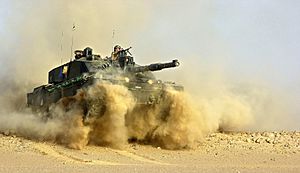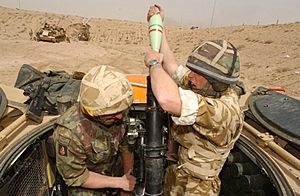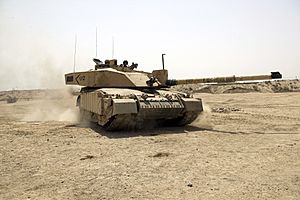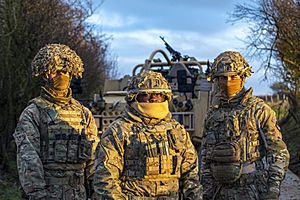1st (United Kingdom) Division facts for kids
Quick facts for kids
|
|
|---|---|
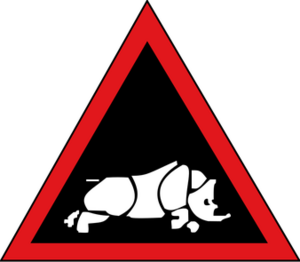
Divisional insignia adopted in 1983
|
|
| Active | 1809–Present |
| Country | |
| Branch | |
| Type | Light infantry |
| Part of | Field Army |
| Garrison/HQ | Imphal Barracks, York, United Kingdom |
| Anniversaries | Peninsular Day |
| Engagements | Gulf War Iraq War |
| Commanders | |
| Current commander |
Tom Bateman |
| Insignia | |
| c. 1939–1960s |  |
| c. 1960s–1983 |  |
The 1st (United Kingdom) Division is a very old and important part of the British Army. It has been formed and changed many times since 1809.
Originally called the 1st Division, it fought in the Peninsular War (part of the Napoleonic Wars). It was then disbanded in 1814. But it quickly reformed in 1815 to fight at the famous Battle of Waterloo. After helping to occupy France, it was disbanded again in 1818.
Over the years, the division was brought back whenever needed. It served in the Crimean War, the Anglo-Zulu War, and the Second Boer War. In 1902, it became a permanent part of the British Army. It fought in the First World War and the Second World War, where it was known as the 1st Infantry Division.
After World War II, the division helped keep peace in Mandatory Palestine. In 1948, it moved to Libya, then to Egypt to protect the Suez Canal. It returned to the UK in 1955 and was disbanded in 1960. But it reformed the very next day in Germany as the 1st Division. In 1978, it became the 1st Armoured Division, meaning it used many tanks.
This armoured division was key in the Gulf War in 1991. It destroyed many enemy tanks and captured thousands of soldiers. After the Cold War ended, it was disbanded again in 1992. But it reformed in 1993 as the 1st (United Kingdom) Armoured Division. It helped with peacekeeping missions in the 1990s.
In 2003, the division went back to the Middle East for the 2003 Invasion of Iraq. It quickly captured the city of Basra. After a few months, it left Iraq, but its brigades continued to deploy there. Since 2010, the division has changed a lot. In 2014, it became the 1st (United Kingdom) Division again. It changed from an armoured division to a light infantry one, focusing on faster, lighter forces. Its headquarters moved from Germany to York in 2015.
Contents
Early History: 1809–1945
The 1st Division was first created on 18 June 1809. This was done by Lieutenant-General Arthur Wellesley, who led British forces in Spain and Portugal. They fought in the Peninsular War, which was part of the Napoleonic Wars.
After the war, the division was broken up in France in 1814. Its soldiers either went back to the UK or were sent to North America. But the division reformed in 1815 for the War of the Seventh Coalition. It fought bravely at the battles of Quatre Bras and Waterloo. At Waterloo, it helped stop the final attack by the French Imperial Guard. After the war, it was part of the army occupying France until 1818, when it was disbanded.
During the mid-to-late 1800s, several groups called the 1st Division were formed for different wars. The division's official history includes those that fought in the Crimean War (1854–1856), the Anglo-Zulu War (1879), and the Second Boer War (1899–1900).
In 1902, the 1st Division became a permanent part of the British Army. It was based at Aldershot. During the First World War (1914–1918), it went to France. It fought on the Western Front throughout the entire war. In 1918, after the war ended, it marched into Germany as part of the occupation force.
The division was briefly renamed in 1919 but reformed quickly. It was the only division kept ready in the years after World War I. Parts of it were sent to the Irish War of Independence and to help in other places. From September to December 1936, the whole division went to Palestine during the start of the Arab revolt. During the Second World War, it was known as the 1st Infantry Division. It fought in the Battle of France, the Tunisian campaign, and the Italian campaign. In 1945, it moved from Italy to Palestine for the end of the war.
After World War II and the Cold War
The 1st Infantry Division stayed in Palestine until May 1948. It helped keep order during the Jewish insurgency. Its soldiers were in places like Haifa and Galilee. As British troops left Palestine, the division moved to Tripoli, Libya, in May 1948. Libya was then occupied by British and French forces.
In 1951, during the Korean War, some engineers and signal staff from the 1st Infantry Division were sent to Korea. The division stayed in Libya until November 1951. Then, it moved to Egypt to join a large British army group. It was based near Ismailia to protect the Suez Canal and British interests in the Middle East. This happened after Egypt ended a treaty that allowed British troops to stay.
As tensions grew, Britain decided to withdraw its forces. The division left for the UK in November 1955. It became the British Army's reserve force. However, it was often used to provide soldiers for other units overseas. On 30 June 1960, the 1st Infantry Division was disbanded.
But the very next day, 1 July 1960, the 5th Division in Germany was renamed the 1st Division. This new division took on the history and badge of the old 1st Division. It was based at Verden an der Aller and was part of the British Army of the Rhine (BAOR). In the late 1960s, new ways to fight tanks and defend deeply were created. This was because of fears of a surprise attack from the Warsaw Pact. Major-General Edwin Bramall led the 1st Division in 1972 and helped develop these new tactics. These ideas were later used by the whole BAOR.
Becoming an Armoured Division
In the 1970s, the UK had less money but still had many military duties. A government report in 1975 suggested changes to the BAOR. It said the army should be restructured. This allowed the BAOR to use the new anti-tank ideas that the 1st Division had started. The BAOR grew to four divisions, each with tanks and infantry.
On 1 April 1978, the 1st Division was renamed the 1st Armoured Division. Its old brigades were replaced with new "Task Forces." The idea was that the division could form up to five fighting groups for specific missions. These groups would be led by tank regiments or infantry battalions. This new way of organizing allowed the commander to change forces quickly.
In 1981, a new defence plan changed the BAOR again. It went from four divisions with two brigades each to three divisions with three brigades. This saved money and soldiers. The "task force" idea was dropped. The 1st Armoured Division was reorganized. It then commanded the 7th, 12th, and 22nd Armoured Brigades. Each brigade had a mix of tanks and infantry.
On 11 November 1983, the division's badge was changed. It combined the old triangle and red outline with a charging rhino. This new badge honored the 1st Armoured Division from World War II. Around this time, the first Challenger tanks arrived. They replaced the older Chieftain tanks.
The Gulf War
Getting Ready
On 2 August 1990, Iraq invaded Kuwait. This started the Gulf War. Iraq also threatened Saudi Arabia, which has a lot of oil. Many countries, led by the US, formed a group to protect Saudi Arabia. This happened as the Cold War was ending, so troops could be moved from Europe to the Middle East.
The British part of this effort was called Operation Granby. On 14 September, the UK announced that the 7th Armoured Brigade would go to the Middle East. This was planned as a six-month mission. The brigade had 9,500 soldiers, 117 Challenger tanks, and many other vehicles. Getting all the needed supplies meant taking parts from other tanks in Germany.
On 22 November, the UK decided to send a larger force, a whole division. The 4th Armoured Brigade joined the 7th Armoured Brigade. The 1st Armoured Division would lead them all. This force had 28,000 soldiers and 7,000 vehicles. This included 179 Challenger tanks and many other armoured vehicles. Most soldiers flew to Saudi Arabia, stopping in Cyprus. The vehicles went by ship. Once in Saudi Arabia, the vehicles were painted for the desert and given extra armour.
The troops stayed at Jubail and worked with US forces. The British commander, Lieutenant-General Peter de la Billière, wanted the division to be used in the main attack. So, the 1st Armoured Division joined the US VII Corps in December. From 18 January 1991, the division trained in the desert, including exercises with American forces. In mid-February, they started daily artillery attacks on Iraqi positions.
The Campaign
The ground war began on 24 February 1991. US forces broke through Iraqi border defenses. The 1st Armoured Division advanced into Iraq the next day. Their goal was to stop Iraqi forces from moving, destroy enemy tanks and artillery, and defeat the Iraqi 52nd Armored Division. They did not need to hold territory, just make sure Iraqi forces could not fight.
The 7th Armoured Brigade attacked first on 25 February. Four hours later, the 4th Armoured Brigade joined. Sandstorms and rain made it hard to see, so vehicles fought at close range. British troops had an advantage with their thermal and night-vision equipment. By dawn on 26 February, the two brigades had defeated the Iraqi 48th Infantry Division. They also attacked parts of the 31st Infantry Division and destroyed most of the 52nd Armored Division.
On 26 February, the division moved towards Wadi al Batin. They attacked several Iraqi reserve positions. They destroyed the remains of the 80th Armored Brigade and other Iraqi units. During the day, US aircraft accidentally destroyed two British Warrior vehicles. With little organized resistance left, the division advanced for two days. They reached the Kuwait City–Basra highway (Highway 80) north of Kuwait City. There, they met up with US and Egyptian forces.
Highway 80 became known as the "Highway of Death." Coalition aircraft destroyed many Iraqi vehicles fleeing Kuwait City. The 1st Armoured Division was tasked with clearing the highway. They moved vehicles, removed unexploded bombs, found Iraqi soldiers, and helped the wounded. By 16 March, the 7th Armoured Brigade began returning to Germany. The division headquarters followed on 23 March. By early April, only a small British force remained.
In just 48 hours, the division defeated a large part of five Iraqi divisions. They captured over 7,000 prisoners. The division destroyed about 300 Iraqi tanks and other vehicles. One tank was destroyed from over 3 miles (4.8 km) away, the longest confirmed kill of the war. The Iraqi forces were often not well-prepared. Overall, British forces had 47 casualties.
After the Cold War
After the Gulf War, the division returned to Germany. The collapse of the Soviet Union meant the Cold War was over. In 1990, the British government announced a plan to reduce the size of the military. The army was to shrink by 18 percent. The British Army in Germany was to be cut in half. Because of this, the division was disbanded on 31 December 1992.
However, in July 1993, the 4th Armoured Division was renamed the 1st (UK) Armoured Division. This reformed division controlled the 4th, 7th, and 20th Armoured Brigades. Each had tanks and infantry. The division's headquarters stayed at Herford. From the 1990s, parts of the division often trained in Poland. The division also became part of the Allied Rapid Reaction Corps, a new NATO headquarters. It was sent on several peacekeeping missions.
In 1995, the British Army formed a multi-national division for peacekeeping in Bosnia. Forces from the 1st (UK) Armoured Division helped lead this mission. This continued until 1999. The division also sent troops to Kosovo and Cyprus for peacekeeping. Detachments also went to the Falkland Islands and Northern Ireland. In 1998, the division received the first Challenger 2 tanks.
In 2001, the division took part in Exercise Saif Sareea II in Oman. This included 66 Challenger 2 tanks. The government did not provide money for desert upgrades like sand filters. This caused many tanks to break down during the exercise.
The Invasion of Iraq (2003)
After the Gulf War, tensions remained between Iraq, the US, and the UK. In 2003, the US decided to invade Iraq. The UK joined them, and the 1st Division was chosen as the main British force. The division was reorganized to include different types of units. These included the 3 Commando Brigade (Royal Marines), the 7th Armoured Brigade, the 16th Air Assault Brigade, and the 102nd Logistical Brigade.
By February 2003, the division was in Kuwait. They trained and practiced until March. The force had about 20,000 soldiers and 120 Challenger II tanks. This was about one-third of the US-led invasion force. The division's main jobs were to secure oil and gas facilities in southern Iraq. They also had to capture the city of Basra and secure three provinces. This area was about half the size of England.
The invasion began on 20 March. Royal Marines and special forces quickly secured coastal oil facilities. This prevented them from being destroyed. The Royal Marines fought for a week to secure the Al-Faw peninsula. Other units quickly secured the Rumaila oil field. Only seven of over 1,000 oil wells were destroyed. US Marines captured Umm Qasr Port. The 3rd Commando Brigade then finished securing the city. With the port safe, humanitarian aid arrived on 31 March.
The 7th Armoured Brigade and 16th Air Assault Brigade captured more oil facilities. They then moved towards Basra. They reached the city's edge within 24 hours. Part of the 16th Air Assault Brigade set up a roadblock on the main highway to Baghdad. They secured Zubayr and surrounded Basra. This was to let civilians leave and encourage Iraqi soldiers to give up. On 26 March, Iraqi tanks attacked, but 15 T-55s were destroyed by British forces.
British forces then entered the city. On 6 April, a large attack was made in the northern part of Basra. It was successful. The rest of the division, about 7,000 infantry, 80 tanks, and 100 Warriors, then entered. Basra was secured by nightfall. The division lost only one tank, due to an accidental friendly fire incident. Three days later, they had more friendly fire casualties from a US aircraft attack.
After the initial fighting, the division helped keep peace and rebuild the area. Their area was expanded to include another province. On 23 June, six British soldiers were killed in an ambush. By May, most of the 3rd Commando and 16th Air Assault Brigades had left Iraq. Other brigades rotated in and out. On 11 July, another division took over the headquarters.
A new Multi-National Division was formed to command all forces in southern Iraq. British brigades from different divisions rotated through this command. The 1st (UK) Armoured Division's brigades deployed several times to Iraq under this command. The final deployment was from December 2008 to April 2009. This marked the end of official British combat operations in Iraq.
Afghanistan Missions
From 2006 onwards, a special task force was created to help stabilize and fight against rebels in Helmand Province, Afghanistan. The 1st Division sent its 20th Armoured Brigade to Afghanistan from October 2011 to April 2012. The 7th Armoured Brigade followed from October 2013 to June 2014. The final deployment was by the 20th Armoured Brigade from June to December 2014. This was when the task force was disbanded and British troops left Helmand.
Army Changes: Army 2020
After its time in Iraq, the division returned to Germany. It continued to be based at Herford. While its brigades were deploying to Iraq, the 1st (UK) Armoured Division commanded three brigades in Germany. These were the 4th Armoured Brigade, 7th Armoured Brigade, and 20th Armoured Brigade. The division had about 17,000 soldiers. In 2006, the 4th Armoured Brigade became the 4th Mechanized Brigade. This meant it had fewer tanks and more infantry. Two years later, this brigade moved to England. This left the 1st (UK) Armoured Division with two brigades.
A defence review in 2010 decided to move all remaining British forces from Germany back to the UK. It also outlined the Army 2020 plan. This plan aimed to change the army from one focused on the War in Afghanistan to one that was more flexible. It created a "Reaction Force" for quick deployments and an "Adaptable Force" for ongoing duties.
On 21 July 2014, the division was renamed the 1st (United Kingdom) Division. This was part of the Army 2020 changes. It began the division's change from an armoured force to one with light infantry. It also started its role in the Adaptable Force. On 2 June 2015, the division headquarters moved from Germany to Imphal Barracks, York.
After this reorganization, the division included several infantry brigades. These were the 4th, 7th, 11th, 38th, 42nd, 51st, and 160th Infantry Brigades. It also included the 102nd Logistic Brigade. More changes happened in 2019 with "Army 2020 Refine." The division then included the 4th, 7th, 11th, and 51st Infantry Brigades. It also had the 2nd Medical Brigade, 8th Engineer Brigade, and 102nd and 104th Logistical Brigades. The division's role expanded to include building capacity, peacekeeping, disaster relief, and helping in the UK. In December 2020, the 1st Military Police Brigade joined the division.
Future Soldier Program
Under the 2021 Future Soldier programme, more changes were made. The division's headquarters will move to Catterick Garrison after 2028. Under this plan, the division is organized as follows:
- 4th Light Brigade Combat Team (Cottesmore)
- 7th Light Mechanised Brigade Combat Team (Catterick)
- 8th Engineer Brigade (Minley)
- 11th Security Force Assistance Brigade (Aldershot)
- 19th Brigade (York)
- 102 Operational Sustainment Brigade (Grantham; headquarters moving to York in 2024, then Catterick in 2029)
- 1st Military Intelligence Battalion (Catterick)
- 5th Military Intelligence Battalion (Edinburgh)
- 2nd Signal Regiment (York, moving to Catterick after 2028)
- 37th Signal Regiment (Redditch)
See also
- List of commanders of the British 1st Division
- List of Victoria Cross recipients from the British 1st Division
- British Forces Germany


